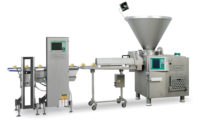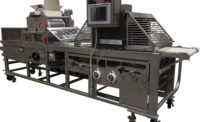Consumer food trends have long impacted bakers and snack manufacturers. Growing demand for specialized products that are gluten-free, whole-grain, low-sodium and more is affecting ingredients selection. Consumer interest in portable, single-serve and re-sealable food packaging is prompting updates to packaging materials and equipment. In turn, these trends—and others—are influencing the type of necessary slicing, cutting and portioning equipment.
“There is definitely an increase in demand for smaller portions that is driving an increase in the demand for the ultrasonic cutters,” says Luc Imberechts, president of Bakon USA Food Equipment Inc., Torrance, CA.
The company has been focusing on high-speed, ultrasonic cutting machines for years. “The ultrasonic cutting technology is ideal for food products, especially fragile pastries, brownies and cakes,” explains Imberechts. “The quality of the cut is unmatched and very accurate. Apart from being fast, our machines are designed for reliability, thanks to the proprietary design of the transducer, booster and blade.”
Bakon USA Food Equipment recently added the Compact model to its ultrasonic cutter line to meet the demands of smaller producers and the need for an affordable, flexible machine that can cut round, square or rectangular products, and products with or without trays or cardboard containers. Other models in the company’s ultrasonic cutting line are a standard cutting machine, a round cake slicer, an in-line cutting machine and an in-line round cake slicer.
“The high-frequency vibration of the blade of [our ultrasonic cutters] also allows them to work better with sticky products, such as icings,” Imberechts says, adding that operators can easily program the machines to slice round cakes or cut cake slabs into squares, triangles, diamond or rectangles.
Telsonic UK Ltd., Poole, England, also has noted a significant increase in demand for ultrasonic cutting and portioning systems due to consumer demand for single-serve and pre-cut products, notes Martin Frost, sales manager for the company. “This growth has been seen across a number of sectors and products,” he says, specifically citing children’s snacks and point-of-sale snacks.
Telsonic’s cutting systems are designed to handle a range of tray-baked products, including flapjacks, malt loaf (a breadlike snack enjoyed in the United Kingdom), slab cake and brownies, with and without inclusions. The company’s latest offerings include a 500-mm-wide blade designed to cut 18-in.-by-30-in. tray-baked products.
When used together, the blade, Telsonic’s MAG-WO20024-S generators and aseptic SE2024-4/IP67 converter (the latter two are specifically designed for food-cutting applications) offer bakers and snack food producers a high-performance cutting and portioning solution with numerous benefits. “These include higher productivity—from the speed of the process and superior portion control—which brings with it greater consistency in weight and the ability to cut without crushing, crumbling or smearing the product,” Frost explains. Additional benefits are reduced waste and downtime due to less product sticking to the cutting blade.
Raising the bar
Consumer demand for healthy snacks and meal replacers that can be eaten anytime and anywhere are also driving sales in single-serve food categories, especially bars.
“The food bar industry is growing at a tremendous rate every year,” says Mike Bond, sales manager, Egan Food Technologies, Grand Rapids, MI. “New companies are emerging everyday wanting to enter the market with a new, unique bar, which they need to form and cut into single-serve sizes.”
Two years ago, the company introduced a two-axis, servo-motor-controlled, guillotine cutter and a slitter wheel and spreader assembly, both of which both can be incorporated into a slab-bar forming line and used to make extruded or slabbed bars, such as cereal, protein, energy or meal, and coextruded bars, such as filled or layered. In addition, the machines can be used to cut crisp rice bars, brownies, biscotti and other dough products.
The guillotine cutter also can be positioned after an extruder or used in other bakery applications. Because it’s servo-motor-controlled, the cutter’s cut length and other parameters are easy to modify using a touchscreen, says Bond.
The servo motor offers bakers and snack producers several other benefits as well: It provides smooth, controlled motion by using feedback to accurately position the cutting blade. It makes changeovers quick and easy because product parameters are stored in the programmable logic controller (PLC). With the addition of ultrasonic generators, operators can reduce the time needed to clean the blade when running sticky products.
To steer foods into a better-for-you direction, many bakers and snack manufacturers incorporate inclusions such as fruits, nuts and dark chocolate into products, particularly bars. These items typically must be sliced or diced to sizes appropriate for the application.
“A growing segment of our business is the inclusion business specific to the snack food industry,” says Tim O’Brien, vice president of sales at Urschel Laboratories Inc., Valparaiso, IN. “It’s been quite strong over the last few years.”
Urschel’s DiversaCut 2110A Dicer and DiversaCut Sprint Dicer can process—slice, dice, cut into strips and more—a variety of ingredients, including vegetables, fruits and meats. “The DiversaCut also is able to do a very precise reduction or dice on the majority of candy and cookie products that we deal with,” adds O’Brien.
Both models offer food processors cut-size flexibility. “Each machine can do a range from as small as 1/16 in. up to 1 in., and all three dimensions don’t need to be the same,” O’Brien explains. Maximum infeed sizes in any dimension for the DiversaCut 2110A Dicer and the DiversaCut Sprint Dicer are 10 in. and 6.5 in., respectively.
Sheet-metal construction, rounded corners and minimal fasteners are just some of the features that make Urschel’s DiversaCut dicers easy to clean and keep sanitary, important considerations for today’s processors. And so is downtime. “The machine is completely cantilevered, so changing the spindles is very easy and very fast with minimal tools, which processors appreciate,” adds O’Brien.
A slice of convenience
While consumer demand for new products and product sizes may be prompting bakers and snack producers to invest in new slicing, cutting and portioning equipment, being able to offer convenient, ready-to-use goods continues to be a driver, too. After all, is there really anything greater than sliced bread? It’s much easier for today’s busy homemaker to reach for a loaf of sliced bread than a bread knife when making sandwiches for school or work lunches. Pre-sliced cake or pie, meanwhile, offers visual appeal and portion control as well as convenience.
“We have seen an increase in inquires for slicing equipment and not just from traditional bakeries, which are our usual customers, but from snack food producers and commissaries as well,” says Sandra Ryan, vice president of operations, Ryan Technology Inc., Hillsboro, OR.
The manufacturer continues to improve its for bread products, such as bagels, ciabatta, croissants, rolls and other bun-like products, with input from customers. “We recently changed to using Ryton coating on our blades, which our customers really love,” Ryan explains. “We have also made improvements to the electronics, blade height adjustment mechanism and other usability features across all our models.”
When it comes to its equipment, “safety is a priority, and we strive to make our slicers as safe as possible to operate,” Ryan says. Access covers to blades have coded, magnetic, interlock devices, and all blade motors have mechanical breaks. Guarding around drive mechanisms has holes, enabling operators to see, but not touch, the mechanisms. The guarding also allows operators to perform some cleaning (using compress air) without removing it.
Ryan cites durability, versatility and quick return on investment (ROI) as other benefits of the company’s equipment. “Our slicers can pay for themselves fairly quickly,” she says. “We had one customer who went from slicing eight buns a minute to 120 buns per minute and figured the cost savings in time would pay for the slicer in less than a year and a half. He purchased one of our smaller units. We have other models that can do over four times the volume.”
FoodTools, Santa Barbara, CA, introduced three slicers for medium to large wholesale bakeries last year at the International Baking Industry Exhibition (IBIE). The ACCUSONIC-2100URF ultrasonic round cake slicer cuts frozen, round products 6-12 in. in diameter and up to 6 in. tall. The ACCUSONIC RPS-100S-D-C robotic ultrasonic slicer and the ACCUSONIC-10UTS top-drive ultrasonic sheet cake slicer handle sticky, difficult-to-cut and delicate products that are round (up to 12 in. in diameter) or diagonal (up to 38 in.).
According to executive vice president Doug Petrovich, the units are flexible, labor-saving and accurate, and reduce rejects. He adds that all FoodTools machines are safe, sanitary and designed and built to Baking Industry Sanitation Standards Committee (BISSC) standards.
Grote Co., Columbus, OH, is seeing increased demand for slicing equipment, particularly in the area of premade, ready-to-eat fresh sandwiches. “Consumers today are embracing premade, fresh gourmet sandwiches and wraps in retail venues, such as convenience stores and coffee shops, outlets that traditionally offered only premade sandwiches with gas-flush packaging,” says Andy Schneider, sales manager-the Americas for the company.
The manufacturer recently expanded the capabilities of its 613 MultiSlicer and now offers an optional pass-through conveying and targeting system on its new 613-VS2 model. The compact system allows bakers and snack food manufacturers to slice and apply baked goods such as Melba toast, bagel chips and sliced cookies directly onto baking trays and screens. As a result, they no longer have to manually place slices onto trays and screens when follow-on baking or toasting is needed.
Schneider says the slicing system offers bakers and snack food manufacturers a significant return on their investment by reducing the labor associated with slicing, toasting, baking and drying products. He adds that also meets the “highest standards of hygiene and sanitary design.”
Beyond cutting and slicing
Bakers and snack producers have numerous other concerns when selecting slicing, cutting and portioning equipment for their operations.
Bond cites versatility, cost and return on investment as factors important to Egan Food Technologies’ customers. “Clients want a quality-built cutter or slitter wheel at an affordable price to provide quicker return on investment,” he says, adding that the company’s clients typically are private-label manufacturers that must be very flexible to manufacture multiple products. “Using a machine that performs well across the board is key to their success.”
O’Brien says Urschel’s customers are also asking for versatile machines that can handle a variety of products and offer a range of cut sizes. They also want equipment that’s easy to clean and maintain, he adds.
As for all food producers, sanitation is important to FoodTools’ customers, as are aspects like flexibility, safety and labor savings. “The demand for labor-saving equipment is pretty constant,” says Petrovich. “It grows each year at a steady pace.”
Frost adds productivity, waste reduction and downtime reduction to bakers’ and snack producers’ list of things they look for when purchasing slicing, cutting and portioning equipment. “Ultrasonic technology effectively addresses these issues with its high speeds, consistency within the process and reliability,” he says.
As long as consumers want products that are easy to use, portable and available in single-serve sizes, containers, bakers and snack manufacturers will continue to seek out slicing, dicing and portioning equipment to create such goods. Manufacturers of such machinery are ready to deliver, too.
Sidebar
Purchasing pointers
Seven equipment manufacturers offer their thoughts on considerations bakers and snack producers should keep in mind when purchasing slicing, cutting and portioning machines:
Safety, energy efficiency and reliability, as well as sanitation, are key decision factors. – Luc Imberechts, president of Bakon USA Food Equipment Inc., Torrance, CA
Manufacturers should consider the following questions: Is the product sticky and would it adhere to standard stainless steel cutting blades? How many different products will the machine be cutting? What are the sizes of those pieces? Where can I buy this type of cutter or slitter? How long is the lead time to build [it]? How much is shipping? What kind of service and support will I get after the purchase? Is the manufacture local to me or on the other side of the globe? – Mike Bond, sales manager, Egan Food Technologies, Grand Rapids, MI
Return on investment (ROI), life cycle cost, safety, sanitation, flexibility, operator training and maintenance support. – Doug Petrovich, executive vice president, FoodTools, Santa Barbara, CA
Slicing and portioning equipment can vary widely in technical design and operating complexity, and bakers and snack producers should evaluate their organic technical capabilities and skills when considering the purchase of new equipment. If the design and complexity of the equipment exceeds in-house capabilities, consider establishing a factory service contract for both routine and emergency maintenance needs. – Andy Schneider, sales manager-the Americas, Grote Co., Columbus, OH
They should think about not only what they need to slice now, but what can they see needing to slice in the future. What kinds of volume projections do they foresee and can the piece of slicing equipment they are considering grow with them? – Sandra Ryan, vice president of operations, Ryan Technology Inc., Hillsboro, OR
Yield, together with the quality and consistency of the cut required. Another important factor is the availability of U.K. application and service support, including spares and response times. – Martin Frost, sales manager, Telsonic UK Ltd., Poole, U.K.
The most important thing is the quality of the cut, so you’re getting the cut you desire. Second, get a machine that’s easy to maintain and sanitary. Sharpness of the knives is also very important, along with the parts to make sure the machine continues to operate well going forward for weeks, months and years. Make sure spare parts are readily available. Downtime is very expensive for processors. – Tim O’Brien, vice president of sales, Urschel Laboratories Inc., Valparaiso, IN











